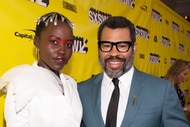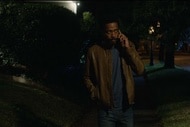Create a free profile to get unlimited access to exclusive videos, sweepstakes, and more!
Exclusive: The Orville's David Goodman rockets into Dark Horse Comics' tie-in series

Fox's fantastically fun space opera series,The Orville, just wrapped up its second season last week and Ed, Kelly, and the entire crew are taking a much deserved respite from their galactic sojourns until Season 3 potentially arrives sometime next year.
April 25th's finale, "The Road Not Taken," gave Seth MacFarlane's far-out show an impressive uptick in eyeballs, and was watched by 2.92 million viewers and delivered a rating/share of 0.7/4 in the 18-49 demographic. Fox has yet to greenlight another season but it seems likely considering The Orville's popularity.
Until then, a fresh Dark Horse tie-in comic miniseries launching this summer from The Orville's Executive Producer and head writer David A. Goodman (Futurama, Star Trek: Enterprise) could keep the property in the public's mind — and SYFY WIRE has an exclusive preview of the first issue.
Written by Goodman and matched with vibrant art by David Cabeza (Catalyst Prime) and colorist Michael Atiyeh (Halo: Escalation, Tomb Raider), this accomplished creative force is gathering to showcase more manic missions from the offbeat outer space crew in The Orville Season 1.5: New Beginnings. These all new enterprises will consist of a pair of two-issue “episodes” bridging the gap between the events of the debut season of MacFarlane’s smash TV series, and the second season which just ended on Fox.
The first of these comic-form episodes begins withThe Orville #1: New Beginnings Part 1 (of two), where en route to a fleet tactical conference, Ed and Gordon investigate a sudden distress signal from a century-old communications buoy belonging to a Union spaceship. Back aboard the Orville, Kelly tries to smooth things over when Bortus insists on enrolling young Topa into school regardless of him being only a few months old.
The second “episode” starts out with The Orville #3: The Word of Avis Part 1 (of two), which sees the Orville intercepting a compact Union ship blasting toward the interstellar territory of the temperamental Krill. The passengers, first thought to be a mild congregation of xenoanthropologists, turn out to be far more interesting and unpredictable than the crew of the Orville ever imagined.
SYFY WIRE chatted with Goodman and Cabeza on this mad dash into the world of comics, how The Orville's on-the-page universe enhances the property's fanbase, and capturing the essence and tone of the adventurous TV series in a new collaboration.
In this first two-part story, what was the plan to make this a seamless transition from TV show to comic?
David Goodman: I set the comic in between seasons one and seasons two. There were a few things that we didn’t stop to explain in season two that I thought fans might be interested in, so I made that part of the story. I wanted fans of the show to read this and feel like it was part of the same universe, but also, I wanted it to work for people who hadn’t seen the show but might be attracted to the genre. And I wanted stories that maybe we wouldn’t do on the show because they wouldn’t work as a television episode but can work in a comic.
Why does The Orville series make such a perfect property for comic adaptation?
DG: I can only answer that for myself. I love writing for “The Orville” because Seth has created a great balance of adventure, social commentary and humor, and that’s what I like in my comic books as well, so I’m doing my best to make that happen.
What is the difference between scripting an episodic series and a comic book?
DG: I’m just learning the ropes, but in scripting a comic book you end up being the writer and director, you’re setting up every camera angle in every panel. Also, the flow of the story is very different, on a television show you can have two people talking for a few pages of script; I don’t think that would work as well for a comic.
You and colorist Michael Atiyeh nail the facial expressions, familiar color palette, and fun panel compositions here. What was the collaboration like and what were you trying to achieve in this translation?
David Cabeza: Drawing a comic from an already designed universe may seem simple, since you have many references, but that can also be a drawback. You have to constantly check that everything is as similar as possible to what has already been established. I like everything to look perfect and in place so the collaboration has been quite close with David, but his script is descriptive enough and there's the show to refer to, so I ask him only when I have some doubts.
I've been reviewing what Michael was doing and he has done a great job! David reviewed what we both were doing—he has been at the center of the creation of The Orville and knows its ins and outs. Then there's our editor, Dave Marshall from Dark Horse, who has coordinated our efforts so well. It's a pleasure to work with this team! I focused on making a good story, being faithful to the details and, although it was the most complicated, trying to portray the characters well.
What are your associations with the show and what was most important for you to capture in the artwork?
DC: To be honest when I was offered to do a test for this miniseries I did not know the show. So, the first thing I did was watch it ... and I loved it! I'm a big fan of science fiction, so I worked hard on those test pages to get the job. Capturing the resemblance of the main characters and the ship itself was my main concern—that the reader who is already a fan does not notice the jump between TV and comics, and that the new reader can get hooked to The Orville universe.
The series is known for its old-fashioned earnestness, space opera hijinks, and modern barbed humor. Will the comic continue to reflect that same rhythm and tone?
DG: Absolutely! It’s been a true pleasure working with David Cabeza on this book, as his talent not only captures the physical look of our actors, but their expressions as well, and this is crucial for capturing the tone of the show in this book.
DC: Well, it's comics and the rhythm changes a bit but we've tried to make the tone feel the same. What we already know from the show is there and what's been created for these comics is within the same parameters. In terms of design of new elements, we've been careful to make them work as something that belongs to this universe. And I've tried hard to give the characters the same personality they have in the series. I think it's the perfect bridge between seasons 1 and 2.
What's the most fun about taking The Orville into a new arena to expand its fanbase?
DG: For me it’s writing a script and watching what happens when David Cabeza brings it to life.
DC: As a fan of the series myself and of the comic medium I'm glad! I remember that when I read the script the first time and I got to see how it was related to some events in both seasons, I smiled and got excited, so I really wanted to start working on it. I hope fans find that same feeling when reading these new stories.
The Orville #1: New Beginnings Part 1 goes on sale July 17, 2019.































